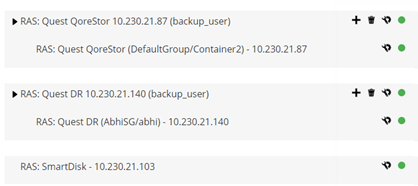Migrating savesets and backup jobs from NetVault SmartDisk to QoreStor
|
• |
The Expire All function is automatically disabled during the migration process. However, it is not disabled on the new target. |
Migrating savesets and backup jobs
|
a |
In the Navigation pane, click Manage Devices. |
|
b |
On the Manage Devices page, note the status of the NetVault SmartDisk device and the QoreStor device. |
|
a |
In the Navigation pane, click Explore Storage. |
|
b |
|
c |
On the Explore Disk Storage page, select the applicable device in the repository table, and click Explore Repository. |
|
d |
|
e |
|
4 |
When you are ready to start the migration process, click Manage Devices in the Navigation pane. |
|
5 |
|
6 |
|
7 |
In the Select target device dialog box, select the QoreStor device to which you want to migrate the NetVault SmartDisk saveset. |
|
9 |
To monitor the progress of the migration, click Check logs. |
The View logs page displays all NetVault logs. To view only the NetVault SmartDisk, enter NVSD in the text box. The process is displayed as a percentage of the savesets that have been migrated.
EMC Data Domain Systems
This section includes the following topics:
About EMC Data Domain Systems
Also, copy the DD Boost library in the NV install directory location “/usr/netvault/dynlib/dd_boost” with a new folder created and renaming the library as follows:
The DD Boost software includes two components:
|
• |
DD Boost Library: This component runs on the NetVault Server, and provides the interface to communicate with the DD Boost Server running on the Data Domain system. |
|
• |
DD Boost Server: This component runs on the Data Domain systems. |
DD Boost offers the following features:
|
• |
Distributed segment processing: DD Boost offloads parts of the deduplication process to the backup client or server, enabling the client or server to send only unique data segments to the Data Domain system. |
|
• |
Advanced load balancing and link failover: This feature lets you combine multiple Ethernet links into a group, and register a single interface with the backup application. The Data Domain system automatically balances the load for backup and restore jobs on multiple interfaces, and routes the jobs to the available interfaces if one of the interfaces in the group goes down. |
|
• |
File replication: File-level replication enables transfer of deduplicated data directly between two or more DD Boost-enabled Data Domain systems, and thus reduces WAN bandwidth requirement by up to 99 percent. The Data Domain systems create and transfer the duplicate copies without using any resources on the backup server. |

